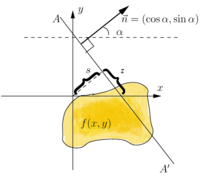Radon transformation

Okay kiddo, imagine you want to know what’s inside a big, huge box. The box is so big and heavy that you can’t pick it up, so you have to think of another way to see what’s inside it.
One way to do this is to shine a flashlight on the box and see where the light shines through.
But what if the box is made of metal or some other material that the flashlight can’t penetrate? That’s where a special kind of light called X-rays comes in.
X-rays can go through some things that normal light can’t, like your skin and your bones. But to get an X-ray image of something like the inside of a box, you need to use a special process called the Radon transformation.
The Radon transformation uses mathematics to figure out what an object looks like on the inside based on how the X-rays pass through it. It’s like looking at the shadow of an object and trying to figure out what shape it is based on the shadow’s shape on the ground.
X-rays are passed through the box, and detectors on the other side measure how many X-rays make it through that particular stop. By doing this from many different angles, and using some tricky math, scientists can create a 3D image of what’s inside the box.
This technology is used in hospitals to take X-rays of bones and other parts of the body, and it’s also used to inspect luggage at airports and to check the quality of materials used in construction. Thanks to the Radon transformation, we can see things that are hidden from our eyes, and find out more about the objects and structures around us!
One way to do this is to shine a flashlight on the box and see where the light shines through.
But what if the box is made of metal or some other material that the flashlight can’t penetrate? That’s where a special kind of light called X-rays comes in.
X-rays can go through some things that normal light can’t, like your skin and your bones. But to get an X-ray image of something like the inside of a box, you need to use a special process called the Radon transformation.
The Radon transformation uses mathematics to figure out what an object looks like on the inside based on how the X-rays pass through it. It’s like looking at the shadow of an object and trying to figure out what shape it is based on the shadow’s shape on the ground.
X-rays are passed through the box, and detectors on the other side measure how many X-rays make it through that particular stop. By doing this from many different angles, and using some tricky math, scientists can create a 3D image of what’s inside the box.
This technology is used in hospitals to take X-rays of bones and other parts of the body, and it’s also used to inspect luggage at airports and to check the quality of materials used in construction. Thanks to the Radon transformation, we can see things that are hidden from our eyes, and find out more about the objects and structures around us!
Related topics others have asked about:
